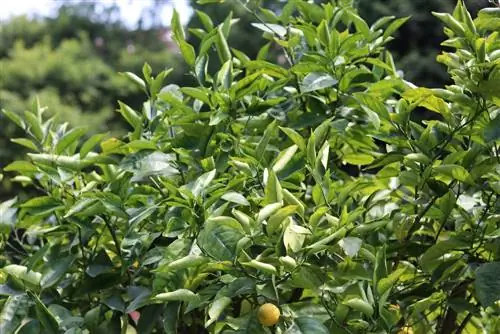- Author admin [email protected].
- Public 2023-12-17 03:39.
- Last modified 2025-01-24 12:45.
Since the orange tree is not hardy, it needs an appropriate winter quarters that optimally combines the two important factors of temperature and light for the orange tree. So it's all about the right location, which must always be frost-free.
Rule of thumb for citrus plants (not hardy): The warmer the winter quarters are, the more light the plants need.
Temperature
- Orange trees, even in their winter quarters, like it to be a little cooler at night than during the day, because that's what the plants are used to in their southern homeland. A temperature is optimal for the orange tree
- at night around five degrees Celsius
- during days up to fifteen degrees Celsius
It doesn't bother the tree if the temperatures reach 20 degrees during the day. However, this should not be the permanent state, otherwise the orange tree will wake up prematurely from its hibernation.
Light
The light in the winter quarters is the second decisive factor when overwintering. You have to assume that the orange tree, or its leaves, has a different understanding of “light” and “dark” than the human eye or human perception. A winter day with only eight hours of daylight, even behind a window, is almost like the dead of night for the tree. That's why the light intensity in the living room is often not enough for the plant to photosynthesize, and it loses its leaves after overwintering in the living room.
Tip:
With a plant lamp you can improve the lighting situation for the tree and other plants.
Optimal winter quarters
As already mentioned, the living room is not the ideal winter quarters for the plant. In addition to the rather poor lighting conditions, the living room is also far too warm. The optimal winter quarters for the orange tree is a greenhouse, a greenhouse or a winter garden if they can be kept frost-free. But here too, care must be taken to ensure that temperatures do not exceed 12 degrees.
Alternative winter quarters
Well, a greenhouse and/or a winter garden are not available to everyone. But this is no reason to forego the citrus plant in summer, even if it is not hardy, because overwintering also works quite well in other locations. An extremely useful winter quarters is a bright staircase if it is unheated. People often try to overwinter the tree in various side rooms in the apartment that are not heated as much. Unfortunately, this doesn't always work because not only the perception of light, but also the perception of temperature is different between people and orange trees. And so, for example, the relationship between light and temperature in the bedroom for the orange tree is not right.
Tip:
In the bedroom, the tree usually doesn't get enough light at relatively high temperatures.
If you don't have a real alternative to your apartment, you should put the orange tree as close to the window as possible so that it gets as much light as possible. But be careful when ventilating, because the tree is not hardy and cannot tolerate forestry.
Tip:
Curtains deprive the orange tree of sunlight and should therefore be removed in winter quarters.
Preparations

Regardless of the winter quarters, the orange tree must be prepared for the move. These include:
- checking for pests
- harvesting ripe fruits
- the removal of immature new shoots
Pests
If you find pests on the orange tree, they must be removed before moving indoors. Often the only thing that helps is to generously remove the affected areas.
Harvesting ripe fruits
You can harvest ripe fruits. Unripe fruits remain on the orange tree even over the winter. They are basically taken care of and then ripen next year.
Care
While choosing the right location is often not that easy, caring for the plant during the cold season is quite easy because the orange tree does not need much care in winter. The following applies here: less is more. Therefore, you can reduce watering and stop fertilizing completely.
Pouring
It is watered when a third of the soil, measured from above, is dry.
Fertilize
If you want, you can fertilize the orange tree once in winter.
After overwintering
Even if this is difficult given our weather conditions, the orange tree should spend as little time as possible in its winter quarters. Therefore, you should get him used to the sun again early on. It will not harm the plant if it is moved back to a sunnier spot in February.
The orange tree is only allowed to be outdoors again when no more frost is expected. This is usually the case after the Ice Saints.






